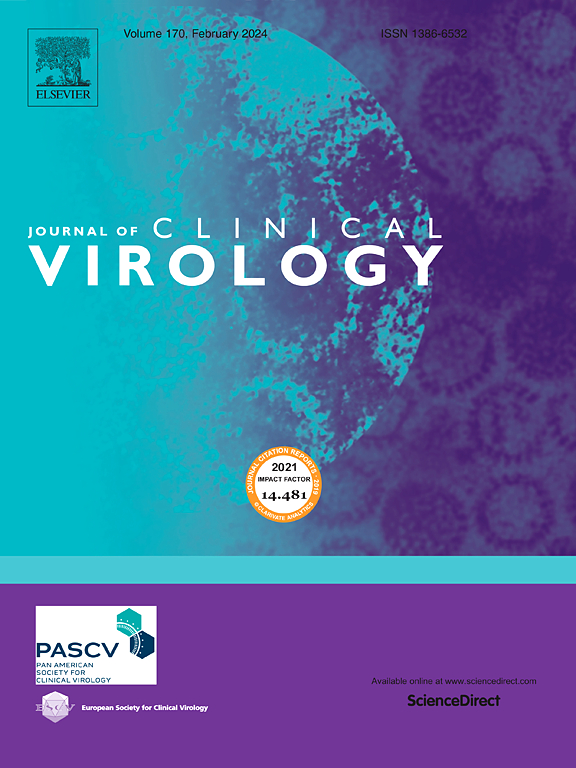快速检测和鉴别人致病性甲病毒的证候法。
IF 3.4
3区 医学
Q2 VIROLOGY
引用次数: 0
摘要
背景:关于许多节肢动物传播的病毒(虫媒病毒)的流行病学、发病机制和公共卫生负担的知识很少。知识不足的部分原因是由于资源限制而缺乏详尽的实验室诊断。在虫媒病毒中,致关节炎和致脑甲病毒在全球广泛传播,可引起严重疾病,并可在区域内同时发生。目的:我们开发并验证了一种多重实时逆转录pcr检测方法,用于检测除Barmah森林病毒外所有常见的人类疾病的甲病毒。研究设计:该试验在单一平行反应中结合了五种抗原复合物特异性测定和一种基孔肯雅病毒(CHIKV)特异性测定。结果:与先前发表的基于pcr的方案进行比较,使用20种不同的人类致病性甲病毒进行广泛的甲病毒检测,发现新的多重检测方法的灵敏度显着提高(Fisher精确测试,p )。与以前可用的检测方法相比,新的检测方法周转时间短、适用于资源有限的环境、抗原复合体的测定以及更高的灵敏度,使其成为甲病毒监测和常规患者诊断的有用工具。本文章由计算机程序翻译,如有差异,请以英文原文为准。
Syndromic approach for rapid detection and differentiation of human pathogenic alphaviruses
Background
Knowledge of epidemiology, pathogenesis, and public health burden is scarce for many arthropod-borne viruses (arboviruses). Insufficient knowledge is partly attributable to the lack of exhaustive laboratory diagnostics due to resource limitations. Among arboviruses, arthritogenic and encephalitogenic alphaviruses are globally widespread, can cause severe disease, and can co-occur regionally.
Objectives
We developed and validated a multiplexed real-time reverse transcription-PCR assay for the detection of all alphaviruses commonly causing human disease except Barmah Forest virus.
Study design
The assay combines five antigenic complex-specific assays and one Chikungunya virus (CHIKV)-specific assay in a single parallelized reaction.
Results
Comparisons with previously published PCR-based protocols for broad alphavirus detection using 20 different human-pathogenic alphaviruses revealed a significantly higher sensitivity of the new multiplexed assay (Fisher’s exact test, p < 0.0001). Detection limits with the new assay ranged from 0.83 cps/μl of extracted O’nyong-nyong virus to 33.05 cps/μl of extracted Western equine encephalitis virus. Antigenic complexes could be clearly differentiated by reactivity, Ct values (t-test, p < 0.0025) and signal intensities (t-test, p < 0.0001), even when testing high alphavirus concentrations potentially capable of causing false-positive PCR results. Testing of high-titred cell culture supernatants of eight important non-alphaviral arboviruses, of 4308 serum samples collected from febrile patients in Benin and Peru, of seven CHIKV-positive diagnostic samples from Brazil, and of non-targeted alphaviruses confirmed excellent diagnostic performance by the new assay, including improved detection of CHIKV, Mayaro and Venezuelan equine encephalitis virus in clinical specimens.
Conclusions
Short turn-around time, applicability in resource-limited settings, antigenic complex determination, and higher sensitivity compared to previously available tests make the new assay a useful tool for alphavirus surveillance and routine patient diagnostics.
求助全文
通过发布文献求助,成功后即可免费获取论文全文。
去求助
来源期刊

Journal of Clinical Virology
医学-病毒学
CiteScore
22.70
自引率
1.10%
发文量
149
审稿时长
24 days
期刊介绍:
The Journal of Clinical Virology, an esteemed international publication, serves as the official journal for both the Pan American Society for Clinical Virology and The European Society for Clinical Virology. Dedicated to advancing the understanding of human virology in clinical settings, the Journal of Clinical Virology focuses on disseminating research papers and reviews pertaining to the clinical aspects of virology. Its scope encompasses articles discussing diagnostic methodologies and virus-induced clinical conditions, with an emphasis on practicality and relevance to clinical practice.
The journal publishes on topics that include:
• new diagnostic technologies
• nucleic acid amplification and serologic testing
• targeted and metagenomic next-generation sequencing
• emerging pandemic viral threats
• respiratory viruses
• transplant viruses
• chronic viral infections
• cancer-associated viruses
• gastrointestinal viruses
• central nervous system viruses
• one health (excludes animal health)
 求助内容:
求助内容: 应助结果提醒方式:
应助结果提醒方式:


